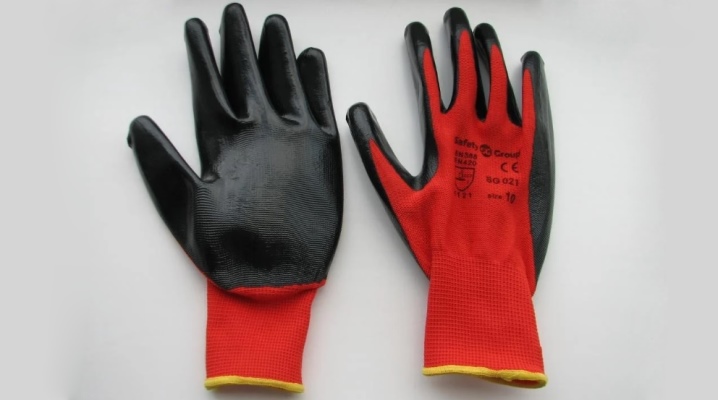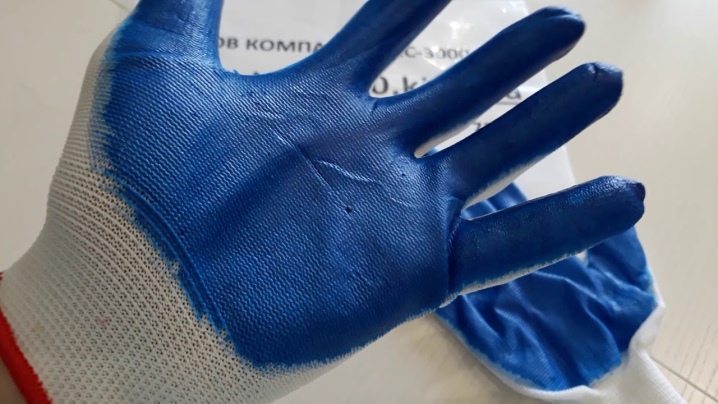Everything you need to know about rubberized gloves

Every production or construction process requires a thoughtful and serious approach to equipping workers. Rubberized mittens are used in a wide variety of industrial and economic activities as one of the basic elements of workwear. The rubber coating performs many useful functions, ranging from improving the degree of adhesion to protecting hands from mechanical damage. In our review, we will talk in more detail about rubberized gloves for workers and construction workers.

Peculiarities
Nowadays on sale you can find a wide range of a wide variety of gloves designed for use in various conditions. They have found their application both in the industrial sphere and in everyday life. One of the most demanded varieties has become rubberized mittens, popularly called "glazier's gloves". They are available in white, orange and green. The main task of such workwear is to prevent the risk of injury when working with smooth and glass surfaces.

Among the main advantages of such gloves are the following:
- polymer coating provides a high degree of grip, thereby preventing the risk of injury during work;
- latex impregnation gives the product durability and increased strength;
- gloves made of rubberized materials protect hands from moisture and corrosive environments;
- rubber gloves are comfortable to wear and do not cause any discomfort.
A pleasant bonus is the affordable cost of gloves, thanks to which almost everyone can afford such protective equipment.

The scope of use of gloves is quite wide. In addition to cutting and cutting glass products, they are indispensable for many production processes:
- loading operations related to the movement and transportation of large-sized items;
- works related to medicines, chemicals, as well as petrochemical products;
- works on installation and adjustment of electrical wiring;
- operations with mechanics;
- works with aluminum profiles, as well as some types of solvents and paints and varnishes.



Rubberized gloves are widely demanded in everyday life.... Due to the embossed texture in the palm area, they are optimal for capturing how many wet surfaces, therefore, on the farm they are often used during gardening work, as well as during repair and cleaning of premises.

One of the varieties of rubberized gloves are models with armbands. They have found application in beekeeping, where they protect beekeepers from insect bites. Rubberized gloves are usually made from cotton materials, nitrite, polyurethane, nylon or latex.
Such a coating remains for a long time, so that the user can do large amounts of work without worrying about the condition of the protective equipment.

What are they?
Depending on the specifics of the application, construction and work rubber gloves are divided into several main categories.
- With single latex coating. Such models belong to strength class 10, they are characterized by increased density and mechanical resistance, due to the special treatment of the inner surface of the gloves. At the same time, they have high parameters of air permeability, which makes them comfortable to use.

- With double latex coating. These gloves are made from 100% cotton jersey with a natural latex coating. Indispensable for work with slippery coatings and glass materials, they have high abrasion resistance.
When used, they do not deform and do not get wet.


- Oil-resistant... Protect hands from the hazardous effects of aggressive chemical acidic and alkaline solutions, as well as oils.
These gloves are not recommended for use with turpentine and chlorinated solvents, as both of these substances can degrade latex.

- Full doused nitrile gloves. Due to the absence of latex, they are characterized by increased hypoallergenicity; instead, nitrile is used in such gloves.
Such a composition is more durable, practical and durable, so it can save your hands from a variety of chemicals and aggressive agents, including acids.
In this case, the composition has an increased degree of elasticity, the extensibility parameter is about 500%.


- Nitrile with incomplete flooding. In such gloves, the base is made of jersey, and in the area of the fingers and on the inside of the palm it is covered with nitrile. These gloves are relevant when working with petroleum products, oils and gasoline, have good adhesion, are practical and durable.

How to choose?
Nowadays the choice of rubber gloves in hardware and building stores is quite wide, moreover, the cost of these products can be different: both for 10 rubles and for 500. That is why users often have questions about the differences between different models and the advisability of buying products at a higher price. The fact is that the cost of rubber gloves depends on several factors.
- Density... It is formed due to the class of knitting, as well as the number of threads. The higher the class, the smaller the distance between the fibers. This greatly increases the strength of the products and increases their wear resistance. Models of grades 10-11 are considered to be of the highest quality; when purchasing them, you must also pay attention to the number of threads in knitting: the more it is, the more dense the working gloves will be. Usually models go on sale, the number of threads in which is 3-5.
- Edge processing quality... This is a very important parameter, because in order for the worker to perform his functions without worrying about safety, the edges and edges of his gloves must be processed with an overlock, otherwise they very quickly become unusable. Despite the fact that products with untreated edges cost an order of magnitude less, you should still refrain from purchasing them.


When buying gloves for doing household chores, it is best to opt for single-poured models.
They are of high quality, while being cheaper than double-poured products. The latter are best used for industrial work where contact with specific products, chemicals, oils and aggressive solutions is foreseen. For use in the winter, it is better to buy insulated models.

Care Tips
To ensure that rubber protective gloves last as long as possible, they must be cared for properly. To do this, you need to follow several rules.
- Do not machine wash rubberized gloves.
- Do not use solvents, gasoline or kerosene to clean the surface.
- After each use, the gloves should be sprinkled with talcum powder without fail: this measure will prevent them from sticking together, and also allow you to clean the surface of dirt.
- With a slight degree of contamination, you can gently wipe the gloves with a toothbrush soaked in a solution of detergent and then dry thoroughly.
- Long-term storage of gloves in a warm, dry place will make them denser.To make them softer and more comfortable to wear, the products should be soaked in water for half an hour with the addition of ammonia at the rate of 4 tbsp. l. 10 liters of water, then rinse in running water and dry.



The following video presents a life hack on how to make gloves rubberized.













The comment was sent successfully.